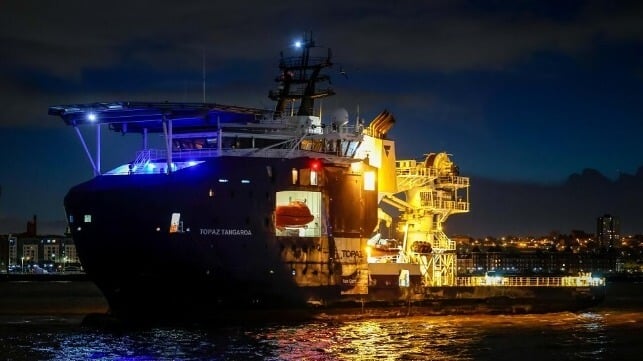Royal Navy's First Subsea Protection Vessel Starts Shipyard Conversion

The first of the UK’s two new ships to protect key underwater infrastructure, Topaz Tangaroa, has arrived at the Cammell Laird yard in Birkenhead. She will become the UK’s first ship dedicated to safeguarding vital seabed telecommunications cables and oil and gas pipelines, beginning operations in just six months’ time.
Military equipment will be installed and the ship painted gray before the ship – the first of two planned Multi-Role Oceanographic Survey (MROS) vessels – begins training with the Royal Fleet Auxiliary to get ready for its first front-line operations this summer.
“It is paramount at a time when we face Putin’s illegal invasion of Ukraine, that we prioritize capabilities that will protect our critical national infrastructure," said Defence Secretary Ben Wallace.
The Royal Navy scoured the world for a vessel which would meet its requirements and selected the Topaz Tangaroa. She was built in Norway four years ago to support a mix of underwater operations such as work on oil/gas rigs, construction, maintenance and inspection work, as well as survey and remotely-operated vehicle/autonomous submarine operations, making her ideal for underwater surveillance and seabed warfare.
The 6,000-tonne vessel, which is equipped with a helipad, crane, and expansive working deck – 1,000 square meters, or the size of five tennis courts – has most recently been operating in the Pacific on underwater construction projects.
The ship also features a moon pool – a large access point in the bottom of the hull through which robot submersibles can be launched.
The vessel, whose new military name is still to be announced, will be crewed by around two dozen RFA sailors, plus up to 60 Royal Navy specialists will operate the undersea surveillance systems and other survey and warfare systems when embarked.
“This is an entirely new mission for the Royal Fleet Auxiliary – and one we relish,” said Commodore David Eagles RFA, the head of the Royal Fleet Auxiliary. “We have been entrusted with supporting a key operation to safeguard the UK’s infrastructure, security and prosperity and that fills all of us in the RFA with pride. These are really exciting times.”
This article appears courtesy of the Royal Navy and may be found in its original form here.
The opinions expressed herein are the author's and not necessarily those of The Maritime Executive.
